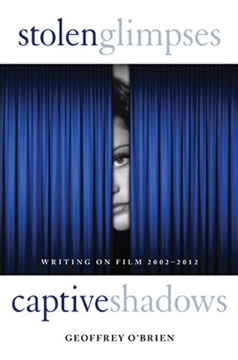Film Literacy
In which Bart attempts to expand his film knowledge, both the history and the methodology, by sticking his nose in a few good books. Having no background in film outside of an intense love and amateur curiosity, nevertheless his goal is to find something, anything, to recommend to you, the constant reader. Suggestions are certainly welcome, with the understanding that this column will be a once-a-month thing, allowing Bart to read and then, loving, review each book.

Previously: Blockbuster. Adventures in the Screen Trade.
With Stolen Glimpses, Captive Shadows, Geoffrey O’Brien reinforces the need for the film critic. As anti-intellectualism creeps into American culture and film analysis gets replaced by Internet-centric obsession with “plot holes” and setting up sequels, this is a man that understands how to engage with cinema and how to communicate that engagement so thoroughly as to make the act of criticism an art in of itself. Stolen Glimpses, Captive Shadows is a collection of 38 essays written by the cultural historian from 2002-2012, providing a deliciously 21st-century take on how movies function today and what their function is in society. Within this swath of articulate persuasion is a love of both high and low brow entertainment, ranging from F.W. Murnau to Stan Lee, and a keen understanding of the symbolism in our lives. Even when it’s clear he didn’t care for a movie, he still finds value in its very existence, and extrapolates how it came to be as a product of history.
O’Brien himself has been active as a poet and critic since the 1960s, with the majority of these essays published in the New York Review of Books. In his writing those two talents meet in the middle, with his prose utilizing flowery, impressionistic language while exuding an air of approachability. His work is dense and highly associative, veering off on tangents of personal anecdotes and making connections with the essay’s subject and its cinematic antecedents. What he has is authenticity, as he expresses a vast knowledge of world culture, language, and the past, present, and future. He also clearly perceives the multiplicity of sources that produce a cinematic text, not limiting his approach to the script or the actors or the directors, although he does show a particular affinity for visual etymology as he repeatedly celebrates the primordial ooze that was the silent film era and how it still reverberates today.
There are several standouts in the more than three dozen essays. “Popcorn Park” forces a reevaluation of Sam Raimi’s Spider-Man(2002) while solidifying what makes the character engaging in the first place. His insistence that it excels at the “soap opera elements” while simultaneously “evoking the mood of curdled domesticity” the director cultivated in A Simple Plan, while extolling the “humorous inventiveness” of The Evil Dead, demonstrates O’Brien’s effortless ability to code switch between what Pauline Kael would call art and trash, all the while interweaving the Pop Art breakthrough of the early days of Marvel Comics and the meta-nature of J. Jonah Jameson and the Daily Bugle as the bustling offices of the notorious House of Ideas.
He’s certainly no perpetuator of “death of the author”, bringing in a film’s auteur in provocative and insightful ways, such as Spielberg projecting his role as director into Minority Report (“Prospero on the Run”) or Mel Gibson’s attempt to recreate medieval passion plays with The Passion of the Christ (“Getting Medieval at the Multiplex”). With Minority Report, he unpacks the ever-present motif of the eye as the camera while positing the scenes in the “theater of operations” as “Spielberg’s daily routine making movies”, with Tom Cruise’s Anderton as a stand-in for a director dealing with studio interference when he is accused of the very Precrime he monitors. The Passion, meanwhile, is bisected within the context of nearly every dramatic presentation of Jesus Christ, Gibson’s influences as a director, and Gibson’s own private life without getting hung up on controversy. What are most stimulating are the parallels he draws between the tone and cinematography of the film and the “stylistic elements” of such pulp and horror works as Exorcist II: The Heretic, Conan the Barbarian, and Mad Max Beyond Thunderdome. O’Brien’s rumination that the film’s achievement is how it subverts its tonal predecessors in how they show protagonists that seek not to be killed whereas Gibson’s Jesus “seeks not to die too soon” really illuminates the purpose of the film as a meditation on torture, however gratuitous.
Must-reads, however, are “Learning to Argue with Pauline Kael” and “Meditations at the Cinema Café”. There O’Brien postulates his overarching thesis on film criticism and film in general. In the former, he confronts his idol the year following her death, explaining how reading her in his youth taught him how to employ discourse: “There was all the room in the world for different responses – but only on condition that they were treated with something approaching the same level of detail and forthrightness, the same faithfulness to moment-by-moment experience, the same refusal to deny that movies exist in a world that keeps forcing its way into even the most hermetic of viewing experiences.” That’s something we can all strive towards. In the latter, he concludes that “movies are of course neither magical nor accidental in origin.” They are recording devices and survey tools, helping humanity to understand where we’ve been and where we’re going, meant to be used to achieve catharsis but more importantly as a means of enlightenment.
I had never heard of Geoffrey O’Brien before reading this book, released in 2013. Having read a collection of Pauline Kael last year and wanting to refine my own rhetorical skills, I decided limiting myself to only Roger Ebert and my favorite online personalities needed to be remedied. For anyone seeking the same, looking for a means to really understand why they love movies but also how to disseminate that, look no further than Stolen Glimpses, Captive Shadows.